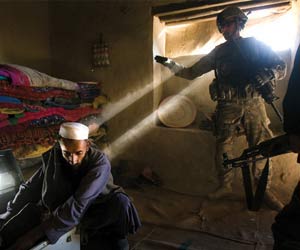This story first appeared on the TomDispatch website.
Here’s the thing: This may be our next “Vietnam moment,” but Afghanistan is no Vietnam: there are no major enemy powers like the Soviet Union and China lurking in the background; no organized enemy state with a powerful army like North Vietnam supporting the insurgents; no well organized, unified national liberation movement like the Vietcong, and that’s just a beginning. Almost everywhere, in fact, the Vietnam analogy breaks down—almost everywhere, that is, except when it comes to us. Because we never managed to leave Vietnam behind, even when we were proclaiming that we had kicked that “syndrome,” it turns out that we’re still there. Our military leaders, for instance, only recently dusted off the old Vietnam-era counterinsurgency doctrine that once ended in catastrophe, shined it up, and are now presenting it as an ingenious new solution to war-fighting. Let’s face it: everything about American thinking still stinks of the Vietnamese debacle, including the inability of our leaders to listen to a genuinely wide range of options.
Now, according to Peter Siegel and Jonathan Weisman of the Wall Street Journal, a “battle” of two Vietnam histories is underway at the White House and the Pentagon. Think of them as dueling books. The president and a number of his advisors have just finished reading Lessons in Disaster: McGeorge Bundy and the Path to War in Vietnam about a White House “being marched into an escalating war by a military viewing the conflict too narrowly to see the perils ahead” and backed by a hawkish national security adviser. The other, a Pentagon favorite, A Better War: The Unexamined Victories and Final Tragedy of America’s Last Years in Vietnam, focuses on a military that by the early 1970s was supposedly winning its counterinsurgency struggle only to be “rejected by political leaders who bow[ed] to popular opinion and end[ed] the fight.”
If it’s a battle of Vietnam histories that Washington wants, should the contest really be limited to these two books? After all, one is about a White House advisor who, like so many of “the best and the brightest,” was decades behind the curve in discovering that he had made a mistake pushing for war; the other, a smiley-faced look at the years 1968-1973 in Vietnam that champions an eerily familiar “stab in the back” thesis in which pusillanimous civilian leaders lead a proud military to defeat.
If it’s a Vietnam syllabus you’re looking for, President Obama, why not start with The Best and the Brightest, David Halberstam’s brilliant dissection of the Vietnam disaster? Having covered Vietnam as a New York Times reporter, he knew a bankrupt war when he saw one. Or why not consider what an American “counterinsurgency” war really meant on the ground? Nothing will give you a more visceral sense of the destruction visited on Vietnam and the Vietnamese in those grim years than Jonathan Schell’s double-barreled classic The Real War. (Why doesn’t anyone in your administration ask Schell, who saw the worst of that war close up, for advice on our new “Vietnam moment”?)
Or you might check out William Gibson’s devastating, sardonically entitled post-war book, The Perfect War: Technowar in Vietnam. It’s a history of what the war managers did and, believe me, it gives the World War II acronym snafu new punch. Or you could pick up Patriots, Christian Appy’s unique oral history of the war as seen from all sides. It provides a perfect way to explore why, faced with overwhelming American firepower, the other side so often refuses to quit.
Not long ago, your special representative to Afghanistan and Pakistan, Richard Holbrooke, picked up a phone in Kabul and called Stanley Karnow, who got a Pulitzer Prize for his 1983 middle-of-the-road, one-volume history of the war. We don’t know how that consultation—in the presence of Afghan war commander General Stanley McChrystal—went, but Karnow did offer this comment to an AP reporter later: “What did we learn from Vietnam? We learned that we shouldn’t have been there in the first place. Obama and everybody else seem to want to be in Afghanistan, but not I.”
My own suggestion to you and your staff for a single-volume history is Marilyn Young’s cautionary tale, The Vietnam Wars: 1945-1990. And then give her a buzz, too, and see what she thinks about the present moment. (Notice, by the way, that “s” on “wars” in her title, since she includes the U.S.-backed French war. When a good history of the conflict in Afghanistan is written, its title, too, will undoubtedly have the plural “wars” in it. After all, we’ve been fighting there on and off for three decades now.)
Finally, there’s a classic from 1967 that should be front and center when discussing the future of the Afghan War. Its title still says it all, even if the topic has yet to make it into your White House when it comes to Afghanistan. I’m talking about Howard Zinn’s Vietnam: The Logic of Withdrawal—which leads me to retired Lieutenant Colonel William Astore’s latest TomDispatch post, focusing on why, then and now, administrations find themselves trapped within such a narrow ambit of opinion.













